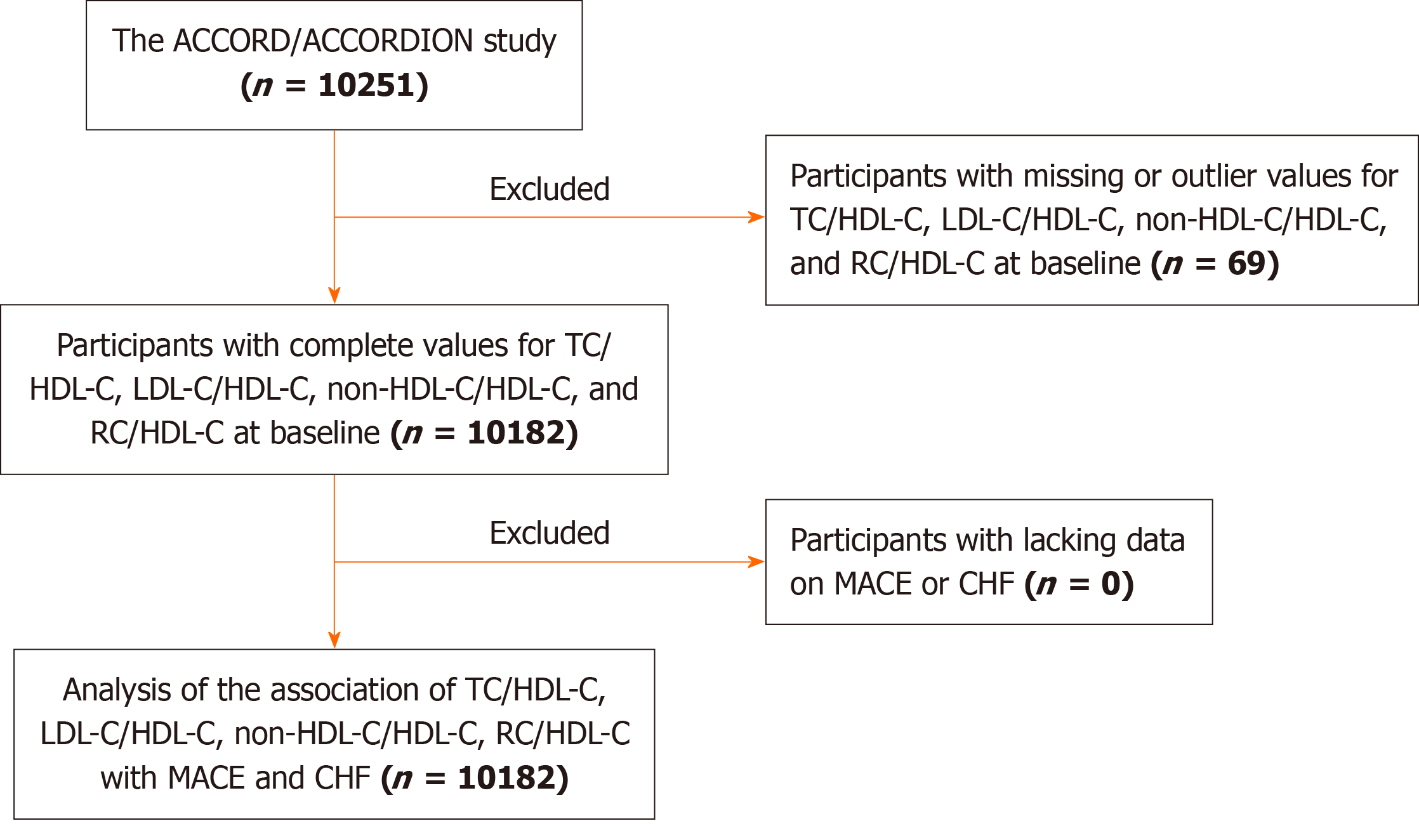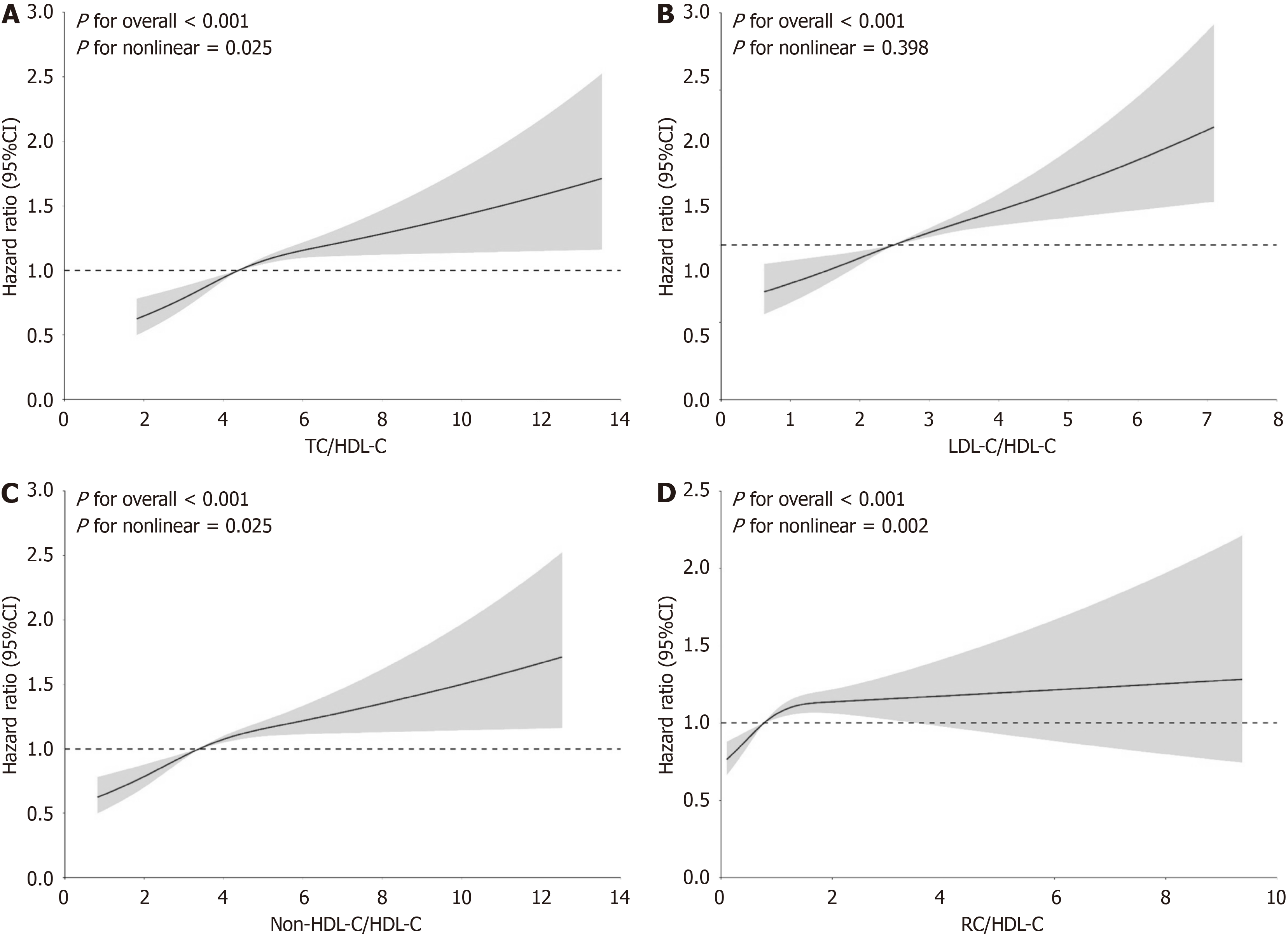Copyright
©The Author(s) 2025.
World J Diabetes. Jun 15, 2025; 16(6): 104120
Published online Jun 15, 2025. doi: 10.4239/wjd.v16.i6.104120
Published online Jun 15, 2025. doi: 10.4239/wjd.v16.i6.104120
Figure 1 Study participant selection from the Action to Control Cardiovascular Risk in Diabetes/Action to Control Cardiovascular Risk in Diabetes Follow-On study.
ACCORD: Action to Control Cardiovascular Risk in Diabetes; ACCORDION: Action to Control Cardiovascular Risk in Diabetes Follow-On; TC: Total cholesterol; HDL-C: High-density lipoprotein cholesterol; LDL-C: Low-density lipoprotein cholesterol; RC: Remnant cholesterol; MACE: Major adverse cardiovascular events; CHF: Congestive heart failure.
Figure 2 Restricted cubic spline analyses of nontraditional lipoprotein ratios to estimate the risk of major adverse cardiovascular events after adjusting for multivariate covariates.
The reference point is the median, with knots placed at the 10th, 50th, and 90th percentiles of each nontraditional lipoprotein ratios distribution. The hazard ratios shown are adjusted for model 4, including sex, age, race, educational level, depression, cigarette-smoking status, duration of type 2 diabetes mellitus, previous cardiovascular events, previous heart failure, previous hypertension, body mass index, systolic blood pressure, diastolic blood pressure, hemoglobin A1c, fasting blood glucose, estimated glomerular filtration rate, insulin use, biguanide use, beta-blocker use, and statin use. A: Total cholesterol/high-density lipoprotein cholesterol (HDL-C); B: Low-density lipoprotein cholesterol/HDL-C; C: Non-HDL-C/HDL-C; D: RC/HDL-C hazard ratios are indicated by solid lines and the 95% confidence intervals by shaded areas. TC: Total cholesterol; HDL-C: High-density lipoprotein cholesterol; LDL-C: Low-density lipoprotein cholesterol; RC: Remnant cholesterol; CI: Confidence interval.
Figure 3 Subgroup and interaction analyses of the associations of nontraditional lipoprotein ratios with major adverse cardiovascular events.
The study population was stratified by sex (female vs male), race (non-White vs White), age (< 65 years vs ≥ 65 years), body mass index (< 28 kg/m2vs ≥ 28 kg/m2), duration of type 2 diabetes mellitus (< 10 years vs ≥ 10 years), previous cardiovascular events (no vs yes), previous heart failure (no vs yes), and HbA1c (< 8% vs ≥ 8%). Adjustments for sex, age, race, educational level, depression, cigarette-smoking status, duration of type 2 diabetes mellitus, previous cardiovascular events, previous heart failure, previous hypertension, body mass index, systolic blood pressure, diastolic blood pressure, hemoglobin A1c, fasting blood glucose, estimated glomerular filtration rate, insulin use, biguanide use, beta-blocker use, and statin use. A: Total cholesterol/high-density lipoprotein cholesterol (HDL-C); B: Low-density lipoprotein cholesterol/HDL-C; C: Non-HDL-C/HDL-C; D: Remnant cholesterol/HDL-C. TC: Total cholesterol; HDL-C: High-density lipoprotein cholesterol; LDL-C: Low-density lipoprotein cholesterol; RC: Remnant cholesterol; BMI: Body mass index; T2DM: Type 2 diabetes mellitus; HbA1c: Hemoglobin A1c; HR: Hazard ratio; CI: Confidence interval.
- Citation: Deng SM, Hu XQ, Zhang XY. Associations of nontraditional lipoprotein ratios with future cardiovascular events in patients with type 2 diabetes mellitus. World J Diabetes 2025; 16(6): 104120
- URL: https://www.wjgnet.com/1948-9358/full/v16/i6/104120.htm
- DOI: https://dx.doi.org/10.4239/wjd.v16.i6.104120











